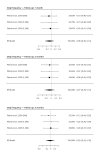Effects of lower limb botulinum toxin injections on gait functional outcomes in stroke survivors: a systematic review and meta-analysis
- PMID: 40856376
- PMCID: PMC12405947
- DOI: 10.23736/S1973-9087.25.08995-6
Effects of lower limb botulinum toxin injections on gait functional outcomes in stroke survivors: a systematic review and meta-analysis
Abstract
Introduction: Spasticity is a relatively common complication of stroke. In the lower limb, it generally involves the ankle and the foot, often leading to equinovarus deformity. Botulinum toxin (BoNT) injections are commonly used to manage spasticity, both in the subacute and chronic phase after stroke; however, their effects on function, particularly gait, are uncertain. This systematic review aims to update the current evidence on the effects of BoNT treatment on gait function in stroke survivors.
Evidence acquisition: This systematic review follows the PRISMA guidelines. We searched five databases (PubMed, Embase, Scopus, CINAHL, Web of Science) for Randomized Controlled Trials (RCTs) published in English that investigated the effects of BoNT injections on gait in individuals with stroke compared to any other treatment or no treatment. Two reviewers independently selected the studies, assessed the risk of bias using the PEDro scale, and extracted the results. Standardized mean differences were calculated and, when possible, meta-analyses were performed, using random effects models.
Evidence synthesis: From a total of 1238 records, 8 studies met the inclusion criteria, all but one study enrolling participants with chronic stroke. Sample sizes ranged from 16 to 468 subjects, for a total of 434 in the experimental groups and 568 in the control groups.. Gait function was assessed using a variety of gait tests, including instrumental gait analysis. Meta-analyses showed no significant effects of BoNT on gait speed, step frequency or step length. One small, underpowered study, with high risk of bias, reported significant improvements of gait speed in individuals with subacute stroke. Other gait-related variables were measured in single small trials, most often finding no differences between BoNT and control interventions.
Conclusions: Our findings indicate that current evidence shows no effects of BoNT treatment on gait speed, and insufficient evidence on its effects on other gait parameters. Adequately-powered, high-quality trials are needed to verify whether BoNT treatment, beyond reducing spasticity, can positively impact functional outcomes other than gait speed in individuals with chronic post-stroke lower limb spasticity and/or during early stroke recovery.
Conflict of interest statement
Figures




Similar articles
-
Multidisciplinary rehabilitation following botulinum toxin and other focal intramuscular treatment for post-stroke spasticity.Cochrane Database Syst Rev. 2013 Jun 5;2013(6):CD009689. doi: 10.1002/14651858.CD009689.pub2. Cochrane Database Syst Rev. 2013. PMID: 23740539 Free PMC article.
-
Physical rehabilitation approaches for the recovery of function and mobility following stroke.Cochrane Database Syst Rev. 2025 Feb 11;2(2):CD001920. doi: 10.1002/14651858.CD001920.pub4. Cochrane Database Syst Rev. 2025. PMID: 39932103 Free PMC article.
-
Prescription of Controlled Substances: Benefits and Risks.2025 Jul 6. In: StatPearls [Internet]. Treasure Island (FL): StatPearls Publishing; 2025 Jan–. 2025 Jul 6. In: StatPearls [Internet]. Treasure Island (FL): StatPearls Publishing; 2025 Jan–. PMID: 30726003 Free Books & Documents.
-
Yoga for stroke rehabilitation.Cochrane Database Syst Rev. 2017 Dec 8;12(12):CD011483. doi: 10.1002/14651858.CD011483.pub2. Cochrane Database Syst Rev. 2017. PMID: 29220541 Free PMC article.
-
Nutritional therapy for reducing disability and improving activities of daily living in people after stroke.Cochrane Database Syst Rev. 2024 Aug 15;8(8):CD014852. doi: 10.1002/14651858.CD014852.pub2. Cochrane Database Syst Rev. 2024. PMID: 39145517 Free PMC article.
References
-
- Stevens E, Emmett E, Wang Y, McKevitt C, Wolfe C. The Burden of Stroke in Europe. Stroke Alliance for Europe 2017;131.
-
- Jørgensen HS, Nakayama H, Raaschou HO, Olsen TS. Recovery of walking function in stroke patients: the Copenhagen Stroke Study. Arch Phys Med Rehabil 1995;76:27–32. https://www.ncbi.nlm.nih.gov/entrez/query.fcgi?cmd=Retrieve&db=PubMed&l... 10.1016/S0003-9993(95)80038-7 - DOI - PubMed
-
- Urrutia R, Miren Gutiérrez-Muto A, Sanz-Morère CB, Gómez A, Politi AM, Lunardini F, et al. Spasticity evaluation with the Amadeo Tyromotion device in patients with hemispheric stroke. Front Neurorobot 2023;17:1172770. https://www.ncbi.nlm.nih.gov/entrez/query.fcgi?cmd=Retrieve&db=PubMed&l... 10.3389/fnbot.2023.1172770 - DOI - PMC - PubMed
-
- Gupta AD, Chu WH, Howell S, Chakraborty S, Koblar S, Visvanathan R, et al. A systematic review: efficacy of botulinum toxin in walking and quality of life in post-stroke lower limb spasticity. Syst Rev 2018;7:1. https://www.ncbi.nlm.nih.gov/entrez/query.fcgi?cmd=Retrieve&db=PubMed&l... 10.1186/s13643-017-0670-9 - DOI - PMC - PubMed
-
- Thibaut A, Chatelle C, Ziegler E, Bruno MA, Laureys S, Gosseries O. Spasticity after stroke: physiology, assessment and treatment. Brain Inj 2013;27:1093–105. https://www.ncbi.nlm.nih.gov/entrez/query.fcgi?cmd=Retrieve&db=PubMed&l... 10.3109/02699052.2013.804202 - DOI - PubMed
Publication types
MeSH terms
Substances
LinkOut - more resources
Full Text Sources
Medical
Miscellaneous

